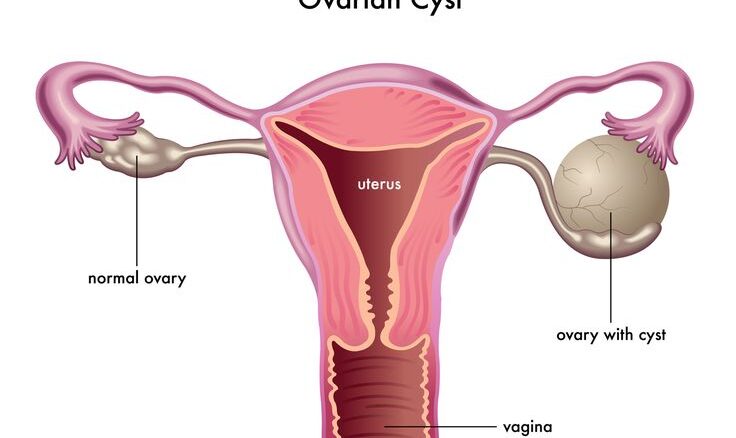INTRODUCTION
Ovarian cysts are sacs filled with liquid materials within the ovaries. The ovaries are reproductive organs that produce follicles for fertilization by the sperm. They also produce sex hormones, estrogen, and progesterone. Every month the ovaries develop follicles containing mature eggs that are released during midcycle.
Most women develop cysts in the process of monthly ovulation. However, most of these cysts present no challenge and resolve over time without treatment. A few cysts may get enlarged and rupture leading to surgical emergencies.
SYMPTOMS
Most cases of ovarian cyst do not have any symptoms. In a few women with large ovarian cysts, they could present with the following.
- Abdominal pains in the lower region.
- Abdominal fullness or feeling bloated
- Fever [lady feels her body is hot]
- Abnormal spotting from the vagina
- Nausea and vomiting
CAUSES
Most cysts arise as a result of stimulation by gonadotrophins [hormones from the brain].
Functional cyst arises as a result of follicles bearing eggs that grow in the ovaries. Some of these follicles do not release the eggs in them and grow bigger to become follicular cysts; when the egg is released, the follicles get bigger and start producing hormones that will support a pregnancy if it occurs and becomes a corpus luteum cyst.
PREVENTION
Avoiding ovulation induction medications could help reduce the risk of ovarian cyst. However, regular pelvic examination and ultrasound scan could help diagnose ovarian cysts early.
COMPLICATIONS
If ovarian cysts grow too large, the following could happen to them.
- Torsion
The ovary or ovaries could twist on themselves.
- Haemorrhage
There could be bleeding into the ovary.
- Rupture
The cyst could rupture.
- Infection
The cyst could get infected.
- Cancerous change
Ovarian cyst in a few cases could become cancerous.
DIAGNOSIS
At the health facility, your doctor may perform a general examination that reveals a pelvic mass.
Laboratory examination done may include:
- CA 125 test. The value of this blood test is increased in the presence of cancerous ovarian mass.
- Other laboratory tests to check for cancer risk include:
Alpha-fetoprotein, Lactate dehydrogenase, and Beta HCG
A Pelvic ultrasound scan is the gold standard for detecting ovarian cysts. Ultrasound scan gives information on the site, size, and presence of solid masses in the cyst. It also picks up the presence of new vessels within the tumour.
CT scan and MRI are used in cases of suspected malignant ovarian cancers to check for the risk of the cancerous tumour and spread to other organs.
TREATMENT
When a doctor makes a diagnosis of ovarian cyst, several options of management could be outlined depending on the size and symptoms the client presents with.
Expectant Management
This involves waiting to see if the mass will resolve over time. A pelvic examination or an ultrasound scan will be carried out at intervals determined by your doctor. Most masses less than 5 cm are likely to resolve. Masses above 10 cm are usually managed by surgery because of the risks of complications arising from them.
Medical Treatment
The use of oral contraceptives is usually not useful in shrinking cysts. However, they could be used to prevent the emergence of new cysts.
Surgery
If ovarian cysts are larger than 5 cm and persist over several months, they should be removed. Complex cysts that contain other materials apart from clear fluid should also be removed. In most cases, for women who have not reached the age of menopause, the cyst is removed leaving the ovary alone. Where the ovary is diseased, it is advisable to remove it with the cyst.
Surgery for noncancerous ovarian cyst is preferably performed by laparoscopy. Laparoscopy involves the use of pinhole incisions with the aid of a camera to access the abdominal cavity. It is the favoured option of management as it is minimally invasive and reduces the risk of further adhesions among other benefits.
Laparotomy should be reserved for a patient with a risk of malignancy or patients with cysts that cannot be removed laparoscopically.
WHEN TO SEE A DOCTOR
You are advised to see your doctor if you experience the following.
- If you have severe lower abdominal pains.
- If you develop a fever with vomiting

